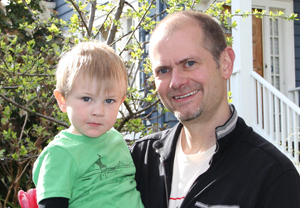 “Time to get in the car,” I say encouragingly to my two year old son as we’re heading down the driveway. After a visit to his grandparents, it’s late for his nap and we need to get home. He stops to pick up a stick – “I found an edger!” he says, and he heads toward the grass to play. “Let’s go see Mama at home,” I suggest, hoping to keep him moving toward the car. “No!” he says, and he steps on to the parking strip and starts swinging the stick along the grass, making buzzing noises. What to do? Pick him up and muscle him into his car seat? Offer choices? Negotiate? Just give up?
“Time to get in the car,” I say encouragingly to my two year old son as we’re heading down the driveway. After a visit to his grandparents, it’s late for his nap and we need to get home. He stops to pick up a stick – “I found an edger!” he says, and he heads toward the grass to play. “Let’s go see Mama at home,” I suggest, hoping to keep him moving toward the car. “No!” he says, and he steps on to the parking strip and starts swinging the stick along the grass, making buzzing noises. What to do? Pick him up and muscle him into his car seat? Offer choices? Negotiate? Just give up?
This situation plays out several times a day in our house – with me wanting my son to cooperate in some activity, and him resisting. It doesn’t matter if it’s a meal, a bath, getting dressed, or going out – any attempt to start something new, even an activity he enjoys, can lead to resistance.
The tiger mom way
In her book, Battle Hymn of the Tiger Mother, Amy Chua describes what she dubs a Chinese style of parenting – based on high expectations, strict discipline, and obedience to parental authority. This style suggests taking a firmly authoritative approach to my son’s resistance, backed by force if need be. But Lao Tzu, the Chinese sage credited with authoring the Tao Te Ching 2,000 years ago, offers another way (the Chinese word “tao” means “way”).
One concept that appears repeatedly in the Tao Te Ching is that of “non-action” – also called “doing without doing”. In practice, this can mean letting things take their course. A passage in Chapter 36 reads “If you want to shrink something, you must first allow it to expand. If you want to get rid of something, you must first allow it to flourish.”
Another way
Realizing I wasn’t going to get my son in the car at that moment without a fight, I decided to give Lao Tzu’s advice a try. If I wanted my son to stop playing with the stick, I needed to first let him play with the stick. I stopped talking about getting in the car and watched him absorbed in his play. “Where else needs edging?” I asked. “Right here,” he said, as he moved farther away from the driveway, buzz buzzing as he went. I watched how he swung the stick with intense concentration – this edging was a big deal for him. “Let’s edge over here!” I suggested, guiding him back toward the driveway.
So it went for about 3 more minutes, with him making buzz buzz noises and swinging the stick in the grass, and with me slowly guiding him back in the direction of the car. When we got to the driveway, I waited for him to pause and then said, “Let’s show Mama the edger!” and at that point, he walked right up to the door of the car carrying the stick, eager to go home and share the story of his latest adventure with his Mom.
I believe a lot of good things came out of this situation, which could have just as easily turned into a contest of wills and a meltdown. Because I chose to put my trust into a “not-doing” way of doing the trip to the car, my son and I both stayed calm and connected, while sharing a spontaneous few minutes of outdoor play. He got to exercise his curiosity and imagination around edging the grass. I got a view into his world – what’s fun for him today? What’s he curious about? Since this interaction, I’ve made lawn care a bigger part of our play time, and it’s been fun for both of us. Maybe most importantly, I reinforced for him the truth that his needs are important to me – that he is a partner in shaping how we spend our time together, and not simply an object to be toted to-and-fro based on my whims and wishes.
Many ways
Of course, not every transition during our day can be handled by letting things take their course. If he’s doing something dangerous, I simply act to remove him from the harmful situation. Similarly, if there is an appointment that can’t be missed and I haven’t allowed enough time to move him along gently, I may need to impose my will by force. But I have come to see that those situations are almost always a result of my poor planning, and they can usually be avoided if I allow enough time for a transition that respectfully lets things take their course.
I don’t always follow Lao Tzu’s way. There are times I throw my son over my shoulder kicking and screaming. But I’ve found that often, if I am willing to trust and let things take their course, the thing that I want done ends up easily accomplished, and sometimes I and my son get the benefit of a wonderful experience along the way that I hadn’t expected. Though not the “Chinese” way of parenting everyone is talking about these days, Lao Tzu’s tao has worked for me and my son.
Fred Ingham is a stay-at-home dad who lives in Seattle. He previously worked in business development and product management for software companies in Silicon Valley and Redmond.












